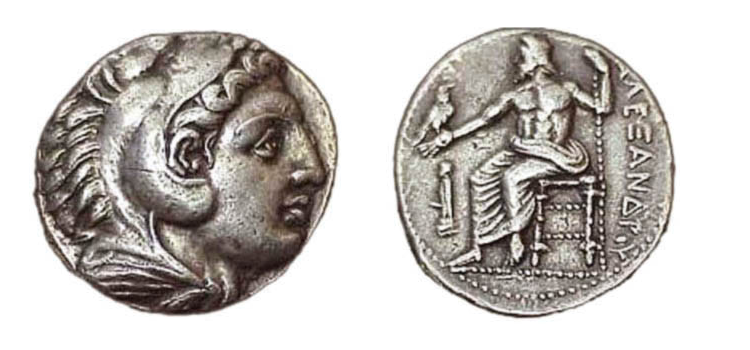Alexander the Great Tetradrachm
Under Alexander the Great, the silver tetradrachm was the most widely-circulated coin. As Alexander built his empire, it was used to pay tribute, as well as mercenaries. After Alexander’s death, the kingdoms that had been under his rule continued to mint the coins bearing his name.

Rise of Alexander the Great
When Phillip II died in 336 B.C., his son, Alexander, became the ruler of Macedonia at the age of 20. While Macedonia had become a strong kingdom under Phillip II, it would grow exponentially under Alexander III. Shortly after inheriting the throne, Alexander launched a military campaign through Asia and northeast Africa. Within 10 years, he had built one of the largest empires of the ancient world. After defeating Persian King Darius III, his empire spanned a massive territory from Greece to northwestern India.
Alexander died in Babylon in 323 B.C., falling short of his goal of conquering Arabia. After Alexander’s death, his empire was divided up among his top generals, as well as his family. While the boundaries shifted amidst power struggles, the largest kingdoms were the Macedonian Kingdom, Seleucid Kingdom, and Ptolemy Kingdom. All three continued to produce coins in Alexander the Great’s name for more than 250 years.
Longevity of the Tetradrachm
Tetradrachms were minted using materials mined from Macedonia and Thrace, as well as using the enormous stash of bullion that Alexander the Great seized from the Persians. According to scholars, Alexander issued tetradrachms from 25 different cities across the ancient world ‑‑ 7 in Europe, 17 in Asia, and 1 in Africa. A tetradrachm was worth four drachms, which, at the time, equaled approximately four day’s wages of a common laborer.
Alexander the Great tetradrachms were minted for nearly three centuries, with many produced posthumously. Like other ancient coins, the design of the coin changed slightly depending on the date and place of its mintage. Nonetheless, all of the Alexander the Great Tetradrachms shared several key elements.
The obverse depicts Herakles, the son of Zeus. He famously became demi-god by completing the 12 Labors assigned to him. The coin depicts the first labor, in which Herakles defeated the fierce Nemean Lion. Herakles is shown proudly wearing the lion’s skin, its open mouth covering the majority of his head and its paws around his neck.
The reverse features Zeus, with his long hair under a crown and a muscular physique. He sits on an ornate throne, holding a scepter in one hand and an eagle in the other. The reverse also include the inscription “ΒΑΣΙΛΕΩΣ ΑΛΕΞΑΝΔΡΟΥ,” which translates to “Of King Alexander.”
